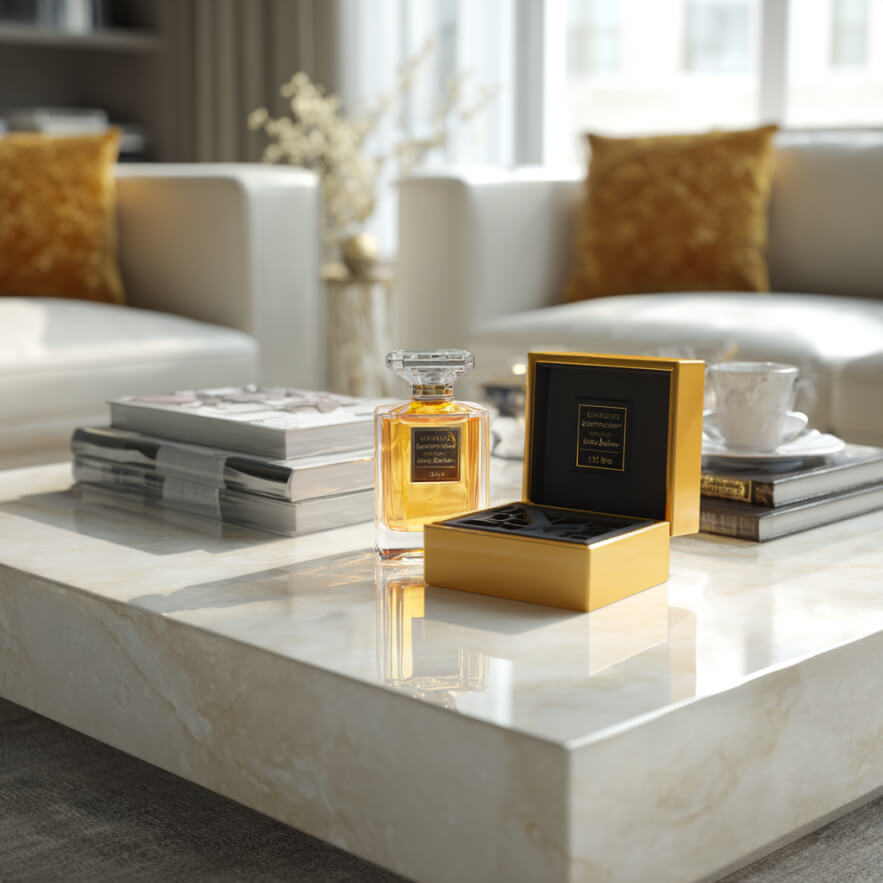When the perfume runs out, the box remains. And more often lately — it remains for a reason. People keep it, display it, reuse it. The box becomes part of the interior, an accessory, an emotional artifact. It’s no longer just packaging that protects a bottle but a piece of the ritual and aesthetics, sometimes just as expressive as the fragrance itself. And the creators behind these boxes know: it should outlive its contents.
What makes a box worth keeping, not throwing away
Not every box becomes a treasure. To be kept, a box must feel unusual and full of character. This could be its material, shape, magnetic closure, multi-layered construction, or even the sound it makes when opening. Anything that breaks the routine of “open – close – discard” starts to act as an emotional anchor.
Collectors and perfume lovers call them keepers — boxes you can’t part with even when the fragrance is gone. These boxes often have a well-thought-out interior: velour pads, suede holders, embossed inserts, thick textured cardboard. Some brands play with tactile contrast — rough on the outside, velvet inside. It creates a feeling of layers, a transition from the outer world to the intimate.
A key factor in whether a box gets kept is durability. It shouldn’t collapse from moisture or deform over time. The closer it feels to a jewelry case or chest, the more likely it will stick around. Details like quality hardware, smooth openings, and tight closures all elevate packaging into an object of its own.
How brands design boxes meant to be reused
Brands have realized that perfume boxes don’t need to be disposable. Where once a graphic designer handled packaging, today it’s a team effort — engineers, material designers, visual stylists. The goal: create something not just protective, but inspiring to interact with. That’s why reuse packaging has become a serious design direction.
Some brands make boxes that transform into useful objects — jewelry cases, organizers, storage containers. Think of magnetic boxes that can easily become containers for letters, samples, or small items. Or boxes with sliding drawers, where the bottle once lay, but later hold whatever you want.
Another trend is modular design, where the box consists of multiple reusable components. The lid becomes a tray; the inner section — a pouch for cards or accessories. This creates the feel of an “intelligent object” — not only beautiful but also practical.Materials are key. More and more brands use recycled premium cardboard, micro-velour, wood, leather, or hand-painted papers. Many ditch plastic — not only for sustainability but for tactile and visual quality. You can feel the difference: the box feels like a luxury item.
Collectors and storage: from shelves to showcases
Boxes that aren’t tossed live on shelves, dressers, or closets — not just as storage but as elements of decor. Collectors group them by color, height, brand, or style. Sometimes the fragrance is long gone, but the box stays — even moving to a new home as part of one’s history.
Some go further and turn packaging into display installations. Using stands, glass lids, or directional lighting, they turn boxes into scent archives. Inside: notes, blotters, fabric scraps infused with the scent. This is no longer storage — it’s capturing an impression through form and texture.
A creative tip: treat the box like a “scent memory capsule.” Inside, save the stopper, ribbons, tester cards — anything that evokes that fragrance. This is especially meaningful for limited editions or discontinued scents.
Lastly, boxes can also be part of resale value and collector markets. In perfume communities, complete packaging can significantly increase the worth of vintage scents. A well-kept box with original inserts becomes part of the product’s legacy. Keeping it means preserving not only aesthetics but also future potential.
Packaging as emotion and ritual
Many users say that unboxing a well-designed perfume is nearly as satisfying as the scent itself. It’s an entry experience — through fabric, cardboard, and the light that spills in as the lid lifts. The slower the access, the stronger the ritual. Like opening a book or vinyl sleeve, it sets the tone.
Some brands enhance this feeling with extras: scented liners, personal cards, ribbons, envelopes. These details form a system of micro-delights, creating memory and attachment. The customer doesn’t just buy perfume; they buy an experience — and the box is where it begins.
The box also gives control over the emotional interaction with the scent. Keeping the bottle inside and opening it only when needed allows a person to regulate their mood and presence. The box acts as a boundary — between outer noise and inner space, daily life and personal ritual.
Packaging designers now admit: they’re designing for feeling, not just for storage. A good box evokes emotion, even when the scent is gone. And it works — packaging has become a sentimental object, living a life beyond the perfume.
Inspired by boxes: upcycling, DIY, and perfume objects
One unexpected trend is the use of perfume boxes in creative repurposing. Some turn them into mini-drawers, picture frames, or art installations. Others use them as candle holders, painting surfaces, or vintage-style tech covers. It all depends on imagination — and the quality of the box.
Etsy and Pinterest are full of DIY ideas for perfume packaging, such as:
- jewelry organizers
- spice or tea drawers
- craft supply boxes
- decorative scent-themed compositions
These projects help keep the connection with a favorite scent while giving the box new purpose. Some perfumers even say it feels rewarding to see their boxes living in someone’s studio, kitchen, or travel kit.
Brands have caught on: they now post reuse ideas on social media, run upcycle contests, and celebrate creative communities. The box is no longer just marketing — it becomes a space for collaboration.If you’re curious about what really makes perfume packaging special, don’t miss. The secret is in the details: what closures, caps, and fabric say about your perfume. You’ll be surprised how much emotion hides in every click and contour.
Because it’s an aesthetically rich, tactile, emotionally meaningful object that can be reused, displayed, or kept as a memory.
Absolutely. If well-made, they can become organizers, cases, keepsake boxes, or even part of home decor.
If it stirs emotion, opens smoothly, feels good to touch, and holds its shape — that’s a “keeper” with potential for a second life.

